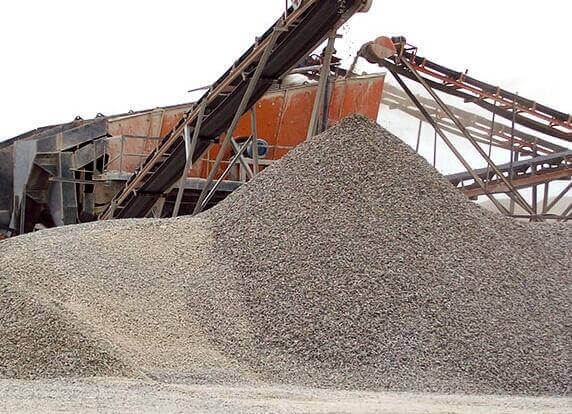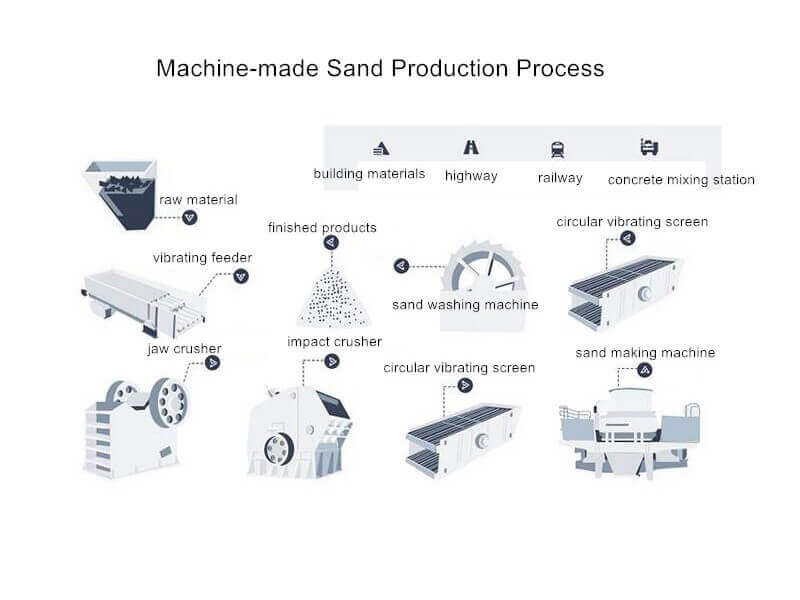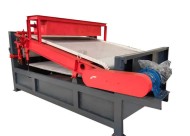As a substitute for natural sand, manufactured sand is easy to obtain, and the particle size gradation is easy to control. At the same time, compared with the mining of natural sand, the acquisition of manufactured sand causes relatively less damage to the environment, and the range of manufactured sand raw materials is vast, which can meet the needs of infrastructure construction. The project has a significant demand for sand and gravel aggregate. Therefore, with the indentation of natural sand mining policies in recent years, manufactured sand has gradually replaced natural sand as the preferred material in the construction field.
Machine-made sand is sand that is crushed and processed by machines. Therefore, raw materials and production equipment for machine-made sand are essential. More than sand-making equipment is required. The related equipment to supply, transport, screen, and clean are needed to assist production. Only in this way can cooperation be efficient, high-energy, and high-yield. The quality control of machine-made sand is one of the more critical aspects of its application and promotion. Only high-quality machine-made sand can prepare high-performance machine-made sand concrete. How to produce high-quality machine-made sand is discussed in detail below.
How to Produce High-quality Machine-made Sand?
In general, producing high-quality machine-made sand requires starting from the following aspects: material selection, equipment, technology, quality control, etc.
Material Selection
- The parent rock’s chemical and mineral composition determine whether the manufactured sand contains harmful substances and whether there is alkali-aggregate reactivity. The parent rock processing machine-made sand must not have potential alkali-aggregate reactivity. It should be produced from clean, hard-textured rocks without weak particles or weathered stones.
- The strength of the parent rock is directly related to the crushing value of mechanical properties. Machine-made sand has specific requirements for strength, so it is required to choose rocks with higher hardness as raw materials for machine-made sand. The strength of machine-made sandstone parent rock should be at least 100MPa for igneous rock, not less than 80MPa for metamorphic rock, and not less than 60MPa for sedimentary rock. Generally recommended are granite, basalt, river pebbles, etc., with a compressive strength of ≥150MPa. They have high silica content, hardness, and good sand shape, which are the basis for producing high-quality sand. For manufactured sand prepared with C60 and above concrete, the parent rock’s compressive strength ratio to the concrete’s strength grade should not be less than 1.5.
- It is essential to control the mud content in raw materials. When mining, prevent soil, weathered rock, tree roots, turf, and other debris from being mixed into the rocks; try to reduce the proportion of harmful raw materials such as mud and phyllite. For example, phyllite will turn to mud quickly when exposed to water. , which will increase the difficulty of the later mineral processing process and hurt the quality of the sand; prevent soil from being mixed during the loading and unloading process of the lumps; when there is a lot of mud mixed in the lumps, the ores should be manually picked out; the lumps should be vibrated Feeder to further screen out the soil.
- Before material selection, samples of the rock base material must be sampled and tested. Rock compressive strength, lithology, sulfide, and sulfate content must meet the requirements to ensure that the quality of the base material is qualified.
In general, control the quality control of machine-made sand by selecting raw materials to produce sand and gravel aggregates that meet the regulations. Choose parent rocks with fewer impurities, such as soil and light substances. Many raw materials can be used as manufactured sand, generally including granite, basalt, river pebbles, cobbles, limestone, calcite, andesite, rhyolite, diorite, diabase, sandstone, tailings, slag, quartzite, etc., etc. Artificial sand made from different rocks has differences in strength and particle size, and corresponding uses will also differ. The following is a brief description of the uses of several ores for making sand:
1) Sandstone: It has high quartz content and is widely used in sand and gravel production lines. The problem of stone powder must be solved during production.
2) Quartz sandstone: Quartz sandstone is a good quality raw sand-making material. It can reach or even surpass natural sand in strength and grain shape.
3) River pebbles: River pebbles are also a good quality raw material for sand-making. They are the best choice to replace natural sand in terms of strength, particle shape, and color.
4) Limestone: It can be used as the raw material of sand and gravel in the sand and gravel production line simultaneously, and the stone powder can also be reused.
5) Basalt: Sand made from basalt is mixed into concrete, making the concrete lighter but still very strong. It also has the characteristics of sound insulation and heat insulation. It is a suitable aggregate for lightweight concrete in high-rise buildings.
6) Granite: Granite with high quartz and low sulfide content is a good quality raw material for sand making, but the powder problem must be solved.
Production Equipment
Machines process machine-made sand, so producing machine-made sand production equipment is important. With the large-scale development of the sand and gravel industry, machine-made sand production equipment has gradually completed the transition from low-yield and low-quality to high-yield, high-quality, intelligent, and environmentally friendly.
Common crushing equipment combinations for producing machine-made sand are:
- Jaw crusher + impact crusher;
- Jaw crusher + cone crusher;
- Jaw crusher + roller crusher;
- Jaw crusher + impact crusher + impact sand-making and shaping machine;
- Jaw crusher + cone crusher + impact sand-making and shaping machine or sand-making system.
Machine-made Sand Production Process
The production process mainly reflects the technology and quality control factors affecting the quality of machine-made sand.
The basic production process of machine-made sand can generally be divided into the following stages: mine rock → coarse crushing → medium crushing (partially equipped with screening) → fine crushing → screening → dust removal → finished machine-made sand.
All-dry, all-wet, and dry-wet combination methods can be selected according to production conditions in the sand and gravel aggregate beneficiation process.
Considering the quality of the sand and gravel aggregate products, it is recommended to use the all-wet sand-making process. Including feeding, crushing, sand making, screening, etc., are flushed with flowing water, which can remove mud, phyllite, and stone powder in the raw materials to the greatest extent through water washing, optimize the distribution of machine-made sand particles, and improve Machine-made sand product quality.
The machine-made sand produced by the dry production process has low moisture content and high output. Still, controlling the fineness and stone powder content is difficult, and the finished materials are prone to segregation. The machine-made sand and stone powder content produced by the wet production process is easy to control but pollutes the environment. The low output can easily lead to unqualified gradation and excessive fineness modulus.
Compared with the dry sand-making process, the full wet sand-making process has less environmental impact and less dust during production. The mud cake after filtering can be used as a raw material for brick making for secondary use.
LATEST PRODUCTS
Tubular Screw Conveyor
【Capacity】6-50 m3/h【Procesible Material】 …
Heavy Plate Feeder
Capacity: 100-240 m3/h Power: 15-45 kW Speed: 0…
Plate Magnetic Separator
【Capacity】8-35 t/h 【Power】1.5-3 kW 【Applic…











